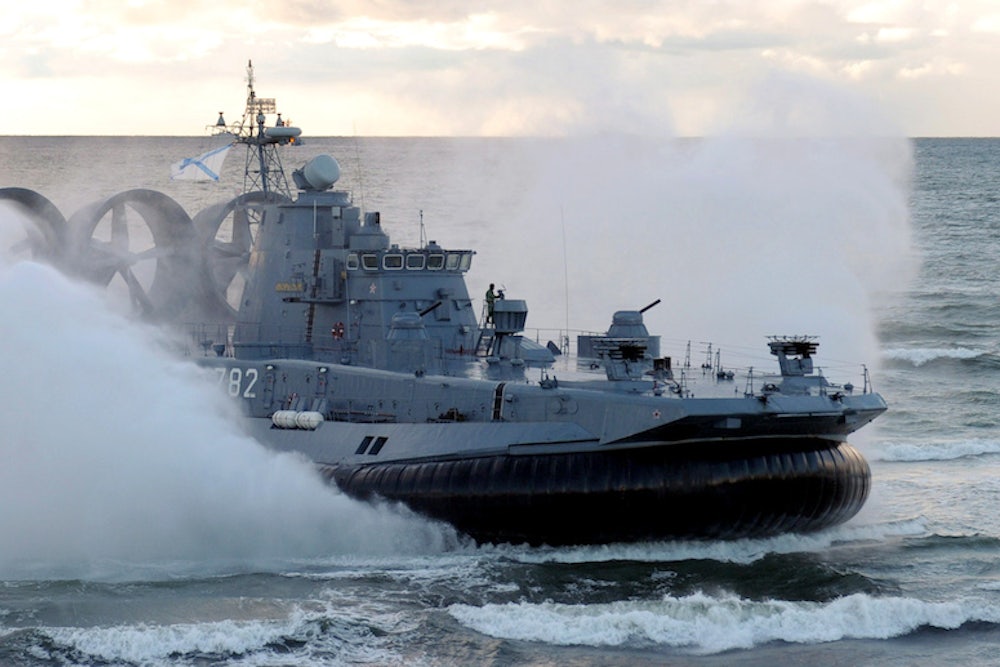Last week, Russia launched a surprise military exercise involving “deepwater bombing and mine planting” on the Baltic Sea coast of its Kaliningrad exclave, which is nestled in between Lithuania and Poland. Lithuanian President Dalia Grybauskaite said the exercise shows that “Russia is trying to threaten all Europe and becoming unpredictable.” She's not alone in worrying. All across the former Soviet borderlands, leaders are looking at Russia’s naked play for Crimea and finding uncomfortable similarities. Ethnic Russians amount to roughly a quarter of the population in both Latvia and Estonia, and a majority in major cities like Narva and Daugavpils. If Simferopol can come back into the Russian fold, the Baltic leaders wonder, why not Narva?
The answer always given, of course, is that Poland and the Baltic States are members of both the European Union and, more importantly, the North Atlantic Treaty Organization. Any incursion into their territory would obligate a response from NATO’s 28 members, including the United States. "Thanks be to God, we are NATO members," Grybauskaite told reporters.
It’s hard to know if NATO’s eastern flank should be thanking God or praying to Him. Russia’s return to military adventurism in Europe comes at perhaps the weakest point in NATO’s 65-year history. The coalition’s disturbing lack of cohesion and preparedness for even small engagements, along with shifting American priorities, cast serious doubt on the guarantee of protection that made Eastern Europe so eager for NATO’s embrace.
Of course, NATO’s leadership has duly made gestures of support for its Eastern European caucus in the aftermath of Crimea. After Poland and Lithuania invoked an emergency meeting under Article 4 of the North Atlantic Treaty for only the fourth time since 1949, NATO cancelled a joint military mission with Russia and announced plans to increase military cooperation with Ukraine. The U.S. also sent six additional fighter jets to a routine air policing mission in the Baltic states. But these are symbolic moves, nothing more.
NATO relies heavily on the United States to project power and deter external threats. The U.S. provides 22 percent of NATO’s common-funded budget and is the organization's largest member—its military spending represents nearly three quarters of all NATO members' military spending combined. As a result, notes Stratfor Chairman George Friedman in his prescient book The Next 100 Years, NATO’s collective defense guarantee is “effective only if the United States is prepared to use force.”
Concerned Poles and Balts seeking hard evidence behind America’s rhetorical support for NATO are bound to be disappointed. Obama’s “pivot to Asia” is only the latest stage in a multi-decade drawdown of U.S. forces in Europe. Only 64,000 U.S. troops are currently stationed there, compared to 450,000 at the height of the Cold War. And U.S. military forces have never been deployed east of the Oder River, which forms the boundary between Germany and Poland. Even planned U.S. missile defense shields for Poland and the Czech Republic were cancelled as part of Obama’s attempted reset with Russia in 2009.
Russia’s intervention in Crimea also came just days after the Department of Defense proposed a 2015 budget that would reduce the U.S. army to its smallest size since before World War II. The budget is a recognition that the U.S. has been spending too much on its military for decades and will no longer be at war for the first time since 2001. It is also a much larger recognition that a debt-ridden, sequestered America cannot be expected to militarily enforce the interests of every ally in every corner of the globe.
Despite this, the rest of NATO continues to operate as if the full force of the U.S. military is behind it. In the interest of rectifying the massive imbalance within NATO, its members agreed in 2006 to each spend at least 2 percent of their GDP on defense (the U.S. typically spends around 4 percent). As of last year, only seven members met that mark. In fact, since 2010, most European countries’ defense expenditures have actually fallen between 8 percent and 30 percent.
That imbalance was apparent during the 2011 intervention in Libya. After the U.S. moved into a “supporting role,” the NATO countries maintaining the no-fly zone quickly began to run out of precision bombs, and the U.S. was forced to provide 80 percent of aerial refueling. In a preview of his post-retirement candor, Secretary of Defense Robert Gates warned at the time of “a dim, if not dismal future” of “collective military irrelevance” for NATO if trends continued.
Ultimately, of course, military spending trends will not tell us what happens if a NATO member is attacked. But Article 5 of the North Atlantic Treaty, which requires the response of every member if one member is attacked, is virtually untested. The only time it has ever been invoked, after the September 11th attacks, was at the behest of the United States. And as Syria has shown, the ghost of Iraq still stalks America’s foreign policy, poisoning the debate over any intervention no matter how righteous.
When it comes to Ukraine, “The United States is not about to risk a conventional war over Russia's neighbors because our interests there are limited and the dispute might escalate to the nuclear level,” Joseph Parent, a University of Miami professor specializing in U.S. foreign policy, told me in an email. “Crimea isn't worth Charleston.” Indeed, President Barack Obama, who came out in favor of Ukraine joining NATO while running for president, is probably thanking his lucky stars today that America’s only commitment to Ukraine is an unenforceable 20-year-old memorandum. And he has made clear that a military response is not on the table in Ukraine. How much does that calculation change if Estonia or Latvia is in the crosshairs?
